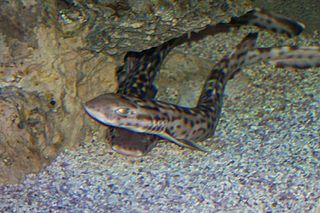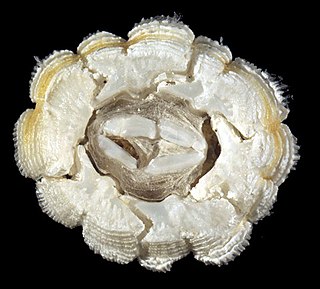
Corals are marine invertebrates within the class Anthozoa of the phylum Cnidaria. They typically form compact colonies of many identical individual polyps. Coral species include the important reef builders that inhabit tropical oceans and secrete calcium carbonate to form a hard skeleton.

A coral reef is an underwater ecosystem characterized by reef-building corals. Reefs are formed of colonies of coral polyps held together by calcium carbonate. Most coral reefs are built from stony corals, whose polyps cluster in groups.

Sea turtles, sometimes called marine turtles, are reptiles of the order Testudines and of the suborder Cryptodira. The seven existing species of sea turtles are the green sea turtle, loggerhead sea turtle, Kemp's ridley sea turtle, olive ridley sea turtle, hawksbill sea turtle, flatback sea turtle, and leatherback sea turtle. All six of the sea turtle species present in US waters are listed as endangered and/or threatened under the Endangered Species Act. The seventh sea turtle species is the Flatback, which exists in the waters of Australia, Papua New Guinea and Indonesia. Sea turtles can be separated into the categories of hard-shelled (cheloniid) and leathery-shelled (dermochelyid). There is only one dermochelyid species which is the leatherback sea turtle.

Clownfish or anemonefish are fishes from the subfamily Amphiprioninae in the family Pomacentridae. Thirty species are recognized: one in the genus Premnas, while the remaining are in the genus Amphiprion. In the wild, they all form symbiotic mutualisms with sea anemones. Depending on species, anemonefish are overall yellow, orange, or a reddish or blackish color, and many show white bars or patches. The largest can reach a length of 17 cm (6.7 in), while the smallest barely achieve 7–8 cm (2.8–3.1 in).

Anthozoa is a class of marine invertebrates which includes the sea anemones, stony corals and soft corals. Adult anthozoans are almost all attached to the seabed, while their larvae can disperse as part of the plankton. The basic unit of the adult is the polyp; this consists of a cylindrical column topped by a disc with a central mouth surrounded by tentacles. Sea anemones are mostly solitary, but the majority of corals are colonial, being formed by the budding of new polyps from an original, founding individual. Colonies are strengthened by calcium carbonate and other materials and take various massive, plate-like, bushy or leafy forms.

The crown-of-thorns starfish, Acanthaster planci, is a large starfish that preys upon hard, or stony, coral polyps (Scleractinia). The crown-of-thorns starfish receives its name from venomous thorn-like spines that cover its upper surface, resembling the biblical crown of thorns. It is one of the largest starfish in the world.

Scleractinia, also called stony corals or hard corals, are marine animals in the phylum Cnidaria that build themselves a hard skeleton. The individual animals are known as polyps and have a cylindrical body crowned by an oral disc in which a mouth is fringed with tentacles. Although some species are solitary, most are colonial. The founding polyp settles and starts to secrete calcium carbonate to protect its soft body. Solitary corals can be as much as 25 cm (10 in) across but in colonial species the polyps are usually only a few millimetres in diameter. These polyps reproduce asexually by budding, but remain attached to each other, forming a multi-polyp colony of clones with a common skeleton, which may be up to several metres in diameter or height according to species.

Sea snakes, or coral reef snakes, are a subfamily of elapid snakes, the Hydrophiinae, that inhabit marine environments for most or all of their lives. Most are venomous, except the genus Emydocephalus, which feeds almost exclusively on fish eggs. Sea snakes are extensively adapted to a fully aquatic life and are unable to move on land, except for the genus Laticauda, which has limited land movement. They are found in warm coastal waters from the Indian Ocean to the Pacific and are closely related to venomous terrestrial snakes in Australia.

The coral catshark is a species of catshark in the family Scyliorhinidae. It is common on shallow coral reefs across the Indo-West Pacific, from Pakistan to New Guinea. Reaching up to 70 cm (28 in) in length, the coral catshark has an extremely slender body, a short head and tail, and two dorsal fins that are angled backwards. It can be identified by the numerous black and white spots on its back, sides, and fins, which often merge to form horizontal bars. Furthermore, adult males have distinctively long and thin claspers.

Aipysurus laevis is a species of venomous sea snake found in the Indo-Pacific. Its common names include golden sea snake, olive sea snake, and olive-brown sea snake.

The black-banded sea krait, also known commonly as the Chinese sea snake, is a species of venomous snake in the subfamily Laticaudinae of the family Elapidae. In Japan it is known as erabu umi hebi (ja:エラブウミヘビ), and in Okinawa as the irabu. It is found in most of the warm waters of the western Pacific Ocean.

Whale barnacles are species of acorn barnacle that belong to the family Coronulidae. They typically attach to baleen whales, and sometimes settle on toothed whales. The whale barnacles diverged from the turtle barnacles about three million years ago.

Spawn is the eggs and sperm released or deposited into water by aquatic animals. As a verb, to spawn refers to the process of releasing the eggs and sperm, and the act of both sexes is called spawning. Most aquatic animals, except for aquatic mammals and reptiles, reproduce through the process of spawning.

Coral reef fish are fish which live amongst or in close relation to coral reefs. Coral reefs form complex ecosystems with tremendous biodiversity. Among the myriad inhabitants, the fish stand out as colourful and interesting to watch. Hundreds of species can exist in a small area of a healthy reef, many of them hidden or well camouflaged. Reef fish have developed many ingenious specialisations adapted to survival on the reefs.

Leptogorgia virgulata, commonly known as the sea whip or colorful sea whip, is a species of soft coral in the family Gorgoniidae.
Emydocephalus annulatus, commonly known as the turtleheaded sea snake or egg-eating sea snake, is a species of sea snake that can be found in waters of Oceania near Australia and some Pacific Islands such as the Philippines and the Loyalty Islands of New Caledonia. The geographic range is sporadic, for example, with populations distributed near the eastern and western coasts of Australia in the Great Barrier Reef and the Timor Sea reefs, respectively. They do not, however, occur in the Gulf of Carpentaria along the north coast.

Platylepas is a genus of barnacles in the family Platylepadidae of the subphylum Crustacea.

Platylepas hexastylos is a species of barnacle in the family Platylepadidae. It is native to the Indo-Pacific Ocean where it lives as a symbiont of such large marine creatures as the dugong, the green sea turtle, the olive ridley sea turtle, or the loggerhead sea turtle.

The Phestilla Minor is a species of sea slug in the Trichechidae family. It is a type of aeolid nudibranch under the aeolidina suborder. The Phestilla Minor is a benthic sea slug that is a very small, slow-moving organism found in marine habitats all over the world.

Conopea galeata is a species of colonial barnacle in the family Archaeobalanidae. It lives exclusively on gorgonians in the western Atlantic Ocean, the Caribbean Sea and the Gulf of Mexico.

















